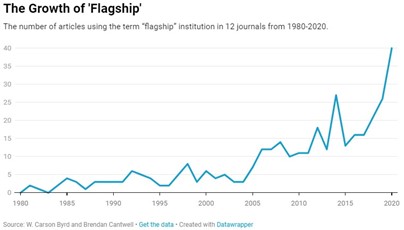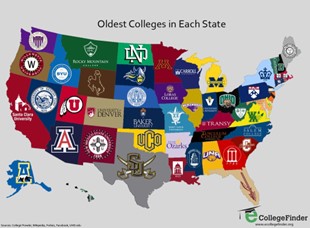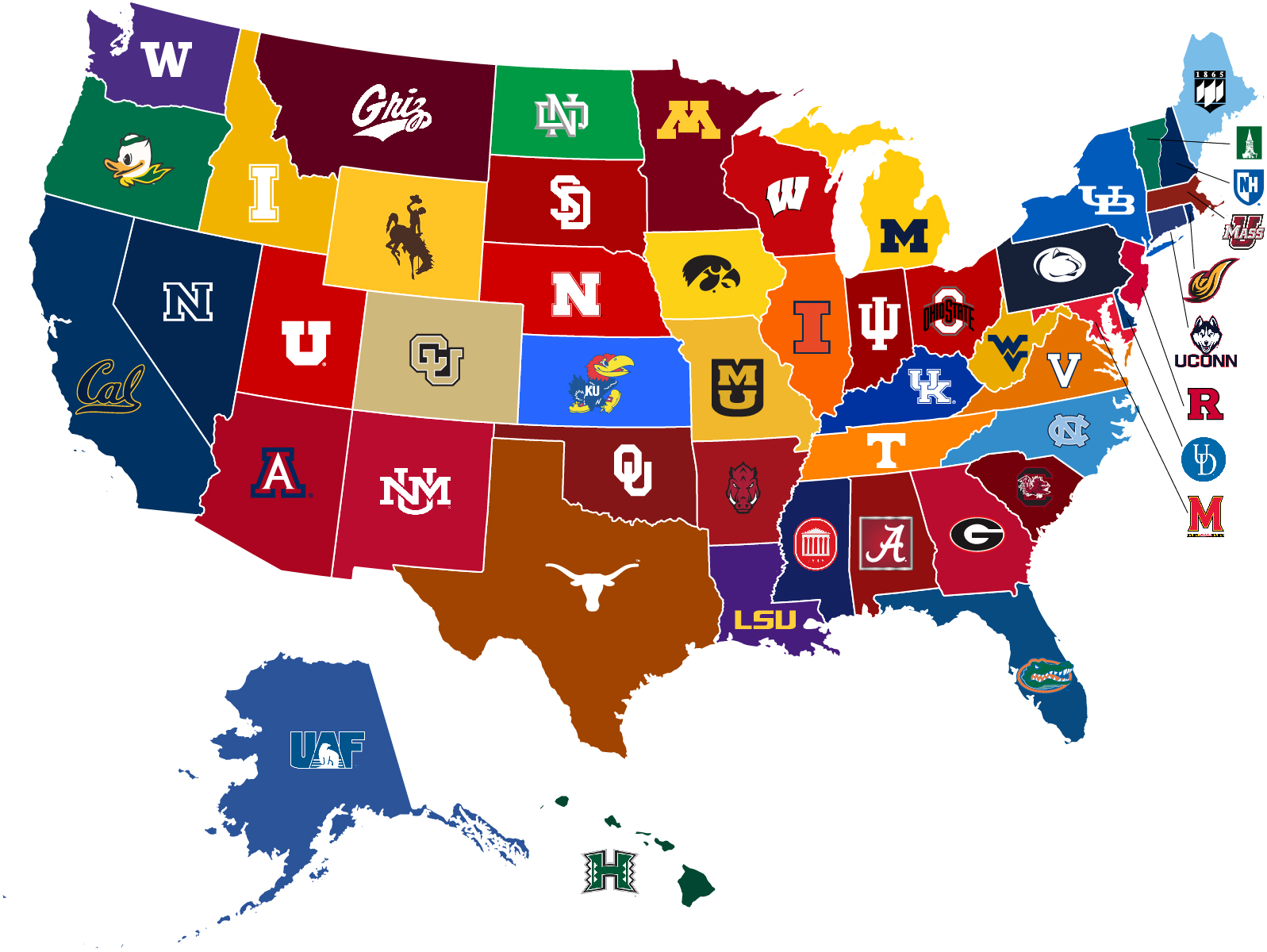

As I grow older, I have learned that the most conflicts most intractable are rooted in different understanding of words we use every day. Discrimination, fairness, equality, love – we use terms that we have not taken the time to define to others. Love can have at least eight different meanings and yet, we assume the other person will know which one we mean.

As I began to research colleges in the mid-1980s, there was a new term being used to describe some colleges – flagship institution. The term seemed to allow a certain group of universities in each state to assert their preeminence over other state institutions. Having three degrees from the U. of Virginia myself, I always enjoyed thinking my college was better than Virginia Tech even though Virginia Tech was larger and had engineering, agricultural, and veterinary academic programs better than UVA.
The best article on this topic was written by Brendan Cantwell (Michigan State U. higher education faculty) and W. Carson Byrd (U. of Michigan academic leader) in the Chronicle of Higher Education (2021) titled, “The ‘Flagship’ Folly – The nautical metaphor is a shoddy classifier of colleges — but a clear signal of higher ed’s obsession with status.”
Cantwell and Byrd conducted an analysis of “350 articles in 12 academic journals since 1980 that used the term “flagship” to refer to colleges. Of those, only 8% of all articles examined included any definition of what constitutes a flagship college.” And they continued, “None of the articles offered a clear and compelling definition of the term.” They concluded by saying that “flagship university is a confusing term, and those of us who work in higher ed should probably avoid it altogether unless we can settle on a clear definition of what it means.”
In addition, their research of indicated that the term “flagship institution” was rarely in print before 1980 and they found that only about “five articles a year mentioned flagship universities from 1980-2005.” The term began a fast rise in fashion starting in 2006. Cantwell and Byrd indicated that “from 2006-2015, the number of articles using the term crept up to between 10 to 15 articles a year.” And after a big drop in 2015, the use of “flagship” university has rapidly increased. They state that “a third of all articles mentioning the term “flagship” as regarding a university in the journals we examined were published since 2015.”

As I began to study higher education in the early 1990s, I found it fascinating that the top ranked and most well-known public colleges in the state would often get the most money from the state. A comparable analogy might be investing the majority of a family’s education funds on the children most likely to be successful. It makes pragmatic sense, but if we assume that families and governments value fairness and equity, giving more money to the more privileged colleges does not align with this value. My higher education colleague, Sarah Schiffecker, reminded me, the “prestige paradox” is an actual psychological concept in which “high-status people are more preoccupied with how others view them,” which can lead them to be less willing to acknowledge that their alma mater may not be elite.

In 2019, Alexis Marshall stated, “Flagship universities receive almost 40% more state funding per full-time undergraduate student than other public four-year schools.” Brian Mitchell, former Bucknell University President, stated that “there is a growing disconnect between flagship publics and the regional public sector institutions. The latter do not have the reputation, alumni base, facilities, breadth of programs, personnel, and resources to mimic the public flagship’s admission recruiting beyond state boundaries.”
One other example came from the state of Virginia where James Murphy, in 2020, discovered that “Compared to community colleges, four-year institutions in Virginia receive 68% more in funding per full-time equivalent (FTE). William & Mary and Virginia Military Institute (VMI)—with $1 billion and $540 million endowments—earn double as much per FTE than the states’ two-year institutions.”
In short, I decided I wanted to dig further into the various understandings of the term “flagship institution.” I wanted to know if the defining elements for flagships hold true when tested in all 50 states. The most recent listing of state flagship institutions was drawn from a September 2022 Brookings Institution paper that included the list below. This list mirrors a list of flagship institutions provided by Oglethorpe University for a scholarship program. Oglethorpe indicates that their list is drawn from the College Board, but I was unable to find where (and how) the College Board defined this term. The only changes I made to the list below was to add the additional institutions in New York, Texas, and Florida, where the state legislatures specifically identified more than one flagship institution.
Prevailing Acknowledgement of Each State’s Flagship Universities
| # | 54 State Flagships | # | 54 State Flagships | # | 54 State Flagships |
| 1 | Alabama | 18 | Louisiana St. | 35 | Oregon |
| 2 | Alaska Fairbanks | 19 | Maine | 36 | Penn St. |
| 3 | Arizona | 20 | Maryland | 37 | Rhode Island |
| 4 | Arkansas | 21 | Massachusetts | 38 | Rutgers |
| 5 | Cal Berkeley | 22 | Michigan | 39 | South Carolina |
| 6 | Colorado | 23 | Minnesota | 40 | South Dakota |
| 7 | Connecticut | 24 | Mississippi | 41 | Stony Brook Buffalo |
| 8 | Delaware | 25 | Missouri | 42 | Tennessee |
| 9 | Florida Florida St. U. of South Florida | 26 | Montana | 43 | Texas Texas A&M |
| 10 | Georgia | 27 | Nebraska | 44 | Utah |
| 11 | Hawaii Manoa | 28 | Nevada Reno | 45 | Vermont |
| 12 | Idaho | 29 | New Hampshire | 46 | Virginia |
| 13 | Illinois | 30 | New Mexico | 47 | Washington |
| 14 | Indiana | 31 | North Carolina | 48 | West Virginia |
| 15 | Iowa | 32 | North Dakota | 49 | Wisconsin |
| 16 | Kansas | 33 | Ohio St. | 50 | Wyoming |
| 17 | Kentucky | 34 | Oklahoma |
I decided to review the most common measures mentioned to define flagship institutions and see how these definitions hold up when put to the test. As mentioned by Cantwell and Byrd, early attempts to define flagship institutions include those with “credibility, resources, and carefully constructed prestige (1982)” and “public universities with the highest classification in a state” in which multiple flagships per state were allowed and 65 identified in total (1985). In contrast, a 1987 book on American Higher Education stated that each state should only have one flagship.
Oglethorpe’s State Flagships List (based on College Board)

When it comes to identifying the number of flagship institutions per state, most people would typically assume there is one per state. However, three states have passed bills identifying multiple state flagship institutions. These include:
- The State of Texas – Two flagship institutions – U. of Texas and Texas A&M
- The State of New York – Two flagship institutions – U. of Buffalo and Stony Brook U.
- The State of Florida legislature attempted to vote that the U. of Florida was the only state flagship but when Florida State U. and the U. of South Florida, found out, they made changes to the bill to add them as flagships too. Ironically, U. of Central Florida, not one of Florida’s flagships, is the largest 4-year college in the state.
In the articles I reviewed, the following 10 characteristics were used most often to define flagship institutions.
State Flagship Institutions’ Supposedly Distinguishing Elements
- Ranked higher than other public university in the state
- Older than other public university in the state
- More selective than other public university in the state
- Have higher graduation rates than other public university in the state
- More research focused than other public university in the state
- More doctoral programs than other public university in the state
- Larger in student population than other public university in the state
- More endowment than other public university in the state
- More out of state students than other public university in the state
- Member of the prestigious AAU only 65 members allowed
What follows below is my efforts to check the accuracy of these ten claims used to define flagship institutions.

- Highest Ranked University (based on U.S. News) – Challenges with Choosing…
- Auburn is ranked higher than Alabama (97th vs 137th – 40 spots)
- Clemson is ranked higher than South Carolina (77th vs. 115th – 38 spots)
- Purdue is ranked higher than Indiana (51st vs. 72nd – 21 spots
- Pittsburgh is ranked higher than Penn State (62nd vs. 77th – 15 spots)
- Georgia Tech is ranked higher than Georgia (44th vs. 49th – 5 spots)
2. Oldest University – Challenges with Choosing…

- The College of William & Mary was founded more than 120 years before the University of Virginia, but it was private until 1906.
- Ohio University, opened in 1808, was founded 62 years before Ohio State
- St. Mary’s College in Maryland (1840) was founded 16 years before the U. of Maryland (1856)
- Both Athens State (1822) and U. of North Alabama (1830) were founded before the U. of Alabama (1831)
- U. of Central Oklahoma, U. of Oklahoma, and Oklahoma State were all founded in December 1890 – are they all the flagship institution then?
3. Most Selective University – Challenges with Choosing…
- Maine Maritime Academy (58%) and the U. of Southern Maine (87%) both admit less students than the U. of Maine (96%)
- Northern Arizona U. admitted 78% of applicants versus the U. of Arizona, which admitted 87% of applicants.
- U. of Alaska Southeast (56%) admits 9% less students per year than the U. of Alaska Fairbanks (65%)
- Kansas has a 93% admit rate – and little-known Emporia State U. has an 88% admit rate.
- University of Vermont admitted 64% of applicants, but Vermont Technical College, a 2-year public college, admitted 56% of applicants.
4. Highest 6-Year Graduation Rates – Challenges with Choosing…
- Clemson graduates 7% more of its students in 6 years than the U. of South Carolina (85% to 78%)
- Arizona State graduates 4% more of its students in 6 years than the U. of Arizona (65% to 61%)
- Truman State graduates 3% more of its students in 6 years than the U. of Missouri (72% to 69%)
- The College of New Jersey graduates 3% more of its students in 6 years than Rutgers U. (87% to 84%)
- Kansas State graduates 2% more of its students in 6 years than the U. of Kansas (66% to 64%)
5. Most Research-Oriented University – Challenges with Choosing…
- The Universities of California San Francisco (UCSF) ($1.7B), San Diego (UCSD) ($1.4B) and Los Angeles (UCLA) ($1.4B) all spend more money on research than U. of California Berkeley.
- U. of Alabama Birmingham and U. of Alabama Huntsville spend much more money on research than the U. of Alabama.
- Georgia Tech spends over $1B/year on research vs. the U. of Georgia ($483M)
- Pittsburgh spends $1.1B/year on research vs. Penn State ($1B)
6. Most Doctorates Graduated/Year (2021) – Challenges with Choosing…
- Purdue graduated 776 doctorates versus the U. of Indiana graduating with 375 doctorates
- Virginia Tech graduated 465 doctorates versus the U. of Virginia 297 graduating with doctorates
- N.C. State graduated 505 doctorates versus the U. of North Carolina 433 graduating with doctorates
- Iowa State graduated 325 doctorates versus the U. of Iowa 286 graduating with doctorates
7. Largest University – Challenges with Choosing…
- Michigan State is larger than the U. of Michigan
- Mississippi State is larger than the U. of Mississippi
- Central Florida is larger than the U. of Florida, USF and Florida State
- Boise State U. is larger than the U. of Idaho
8. Largest Endowment – Challenges with Choosing…
- Pittsburgh has $1B more in endowment than Penn State
- Georgia Tech has $1B more in endowment than the U. of Georgia
- UCLA has $1B more in endowment than the U. of California Berkeley
- Purdue has ~$200M more in endowment than the U. of Indiana
9. Most of Out of State Students – Challenges with Choosing…
- Delaware State has a higher percentage of out of state students than the U. of Delaware
- Fort Lewis College has a higher percentage of out of state students than the U. of Colorado
- Coastal Carolina has a higher percentage of out of state students than the U. of South Carolina
- NC School of the Arts has a higher percentage of out of state students than the U. of North Carolina
10. Member of the AAU (American Association of Universities) – Challenges with Choosing…
- Georgia Tech is in the AAU but U. of Georgia is not
- Many states have at least two public institutions in the AAU meaning it is not a helpful differentiator
- There are 20 states that have neither a public nor a private university in the AAU – States with no AAU members – Alabama, Alaska, Arkansas, Delaware, Hawaii, Idaho, Kentucky, Maine, Mississippi, Montana, Nebraska, Nevada, New Mexico, North Dakota, Oklahoma, South Carolina, South Dakota, Vermont, West Virginia, Wyoming.

What do we do with the word “flagship”?
In short, there is not one of the 10 major defining characteristics of flagship institutions that holds true for all 50 states. In most of the characteristics, there are multiple outlying state institutions. So what should we do about our use of this term?
The easy solution would be to ask people to stop using the term “flagship institution.” The term clearly does not hold up when evaluated against any of the factors currently being used to define it. While telling people to stop using the term may be easy to say, based on the extensive growth of the term over the past 30 years, it does not seem to be likely.
Another solution would be to select one defining factor we believe is more important than the others, and use it to redefine flagship institutions. For example, if everyone agreed that the highest ranked (US News) national university would be the flagship institution, there would need to be six flagship university changes (and some reductions in the 3 states where there is more than flagship identified).
My preferred solution is to identify the state flagship institution as the one which has the highest positive gap between expected and actual graduation rate among their students. This is calculated by the US News Ranking but the data is not publicly accessible. This solution would reward the colleges doing the most to impact their students’ likely success.
What Colleges Perform Better than Expected?
“Montclair State University ranks 7th in the nation among all 440 national universities in graduation rate performance – the rate at which students out-perform the anticipated graduation rate of those with similar backgrounds at other schools – in U.S. News 2022-2023 Rankings.
Montclair’s 6-yr graduation rate of 67% out-paces the 49% graduation rate predicted for it. The 18% difference between predicted and actual rates is the 5th best in the nation among public National Universities.
The drawback would be a major realignment of flagship institutions as currently many flagship institutions are so named because they attract a large group of students expected to graduate and therefore, the actual gap between their expected and graduation rate is not as large as many other public universities in the state able to demonstrate much more of an impact on student success.

The most realistic solution would be to redefine the term “flagship university” to be more inclusive of several other universities in each state. This is similar to the approach the states of New York, Texas, and Florida took. This solution does negate the original meaning of the term, “flagship” itself, as I could not find where large fleets of ships have multiple flagships. That being said, we did stop giving out one trophy to the best child several decades ago. Maybe all the public institutions should “receive a trophy” by being referred to “flagship universities”? 😉

